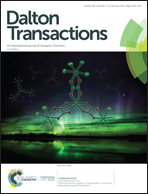Consecutive ligand-based PCET processes affording a doubly reduced nickel pyrazinedithiolate which transforms into a metal hydride required to evolve H2†
Abstract
Our DFT results demonstrate that hydrogen evolution from water catalyzed by a nickel pyradinedithiolate (dcpdt) molecular hydrogen evolution catalyst [NiII(dcpdt)2]2− proceeds via the formation of a square-planar nickel(II) hydride intermediate which is given by unprecedented structural transformation of a doubly reduced triply protonated species [NiII(dcpdtH2)(dcpdtH)]−, afforded as a result of two consecutive ligand-based reductions of [NiII(dcpdt)(dcpdtH)]− through proton-coupled electron transfer (PCET) pathways.



 Please wait while we load your content...
Please wait while we load your content...